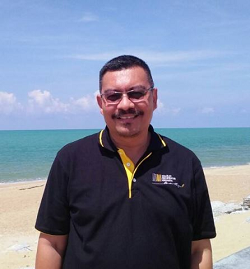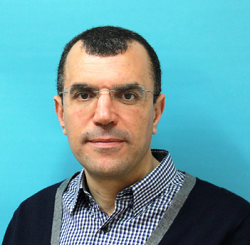|
|
|
Riza Sulaiman - University Kebangsaan Malaysia, UKM

|
Measuring Soft Organs in Human Body : Issues and Challenges
Measuring soft organs in human body need certain criteria. This research introduces measuring technique using algorithms bank method to measure the liver volume of humans, with accuracy and reducing the error rate. The research methodology was divided into four phases, phase one is image source, which is used to convert image source from CT and MRI to DICOM file. Phase two; software application and development, which is used to remove image noise, enhance the liver boundary and liver image segmentation. Phase three; template prototype application and measurement, which is used to create template, compare the source image DICOM file with template and restore an image as template. Phase four; compare the liver volume measurement with Gold Standard reading, which is used to determine accuracy and error rate. The framework was represented in three layers, technique layer, image layer and application layer. Enhancing the liver boundary by a scale-specific gradient magnitude filter and Gaussian filter. Segmentation by hybrid based framework method using three algorithms, fast marching, Geodesic active contour and level set. The study also discussed the issues and challenges in measuring soft organs, which was found during the investigation stage of this research.
Biography
Riza Sulaiman is a Professor in Visualization and Senior Research Fellow in the Institute of Visual Informatics, National University of Malaysia (University Kebangsaan Malaysia, UKM). Before joining the academics. Between 1990-1995, he had experienced working in the private sector (Engineering). He holds a PhD in Mechanical Engineering, a MSc in Advanced Manufacturing Technology from the University of Portsmouth and B.Eng. (Hons) in Mechanical Engineering from the University of Sunderland, United Kingdom. His research area is in Visualisation, CADCAM, Graphics and Medical Imaging. He is a reviewer of more than 30 international journals and conference proceedings. Since 2012, he has published three books in Computer-Aided Design. He is also a member of the Institution of Mechanical Engineers (IMechE), United Kingdom, the International Association of Engineers (IAENG), the Board of Engineers Malaysia (BEM) and the Institution of Electrical and Electronics Engineers (IEEE) Malaysia Chapter and the Malaysia Society for Computer Tomography and Imaging Technology (MyCT). He can be contacted through email riza@ukm.edu.my
|
|
Khalil Drira - LAAS-CNRS, Université de Toulouse, France

|
Semantic-enabled IoT Systems: an overview of recent initiatives and future directions
Significant advances have been achieved in information and communication technologies in the last decade. Recent advances include virtualization technology both at the processing and the communication levels as well as standardization. The progress in networking encompasses Machine-to-Machine (M2M) communications for Internet of Things and big data traffic that constitute active research and standardisation activities in Europe by ETSI, and around the world by OneM2M. The design and deployment of interoperable IoT solutions based on open systems and interfaces are identified as enablers for the digital market. The strategic application domains include e-heath, connected and automated vehicles, advanced manufacturing, energy management and smart homes, buildings and cities. IoT Systems provide advantages in all these various domains. This fast-growing ecosystem is leading IoT towards a promising future. However, IoT systems expansion opportunities are not straightforward. A set of challenges should be overcome to enable IoT mass-scale deployment across various domains including interoperability, complexity, and scalability issues. This talk aims at giving an overview of these challenges. Recent international standardization and R&D initiatives will be investigated. Future directions will be highlighted.
Biography
Khalil DRIRA received the Engineering and M.S. (DEA) degrees in Computer Science from ENSEEIHT (INP Toulouse), in 1988. He obtained the Ph.D. and HDR degrees in Computer Science from UPS, University Paul Sabatier Toulouse, in 1992, and 2005 respectively. He joined CNRS, the French National Center for Scientific Research, in 1993 as a researcher. He is, since Oct 2010, Research Director, a full-time research position at CNRS.
Khalil DRIRA’s research interests include formal design, implementation, testing and provisioning of distributed communicating systems and cooperative networked services. He is or has been involved in several national and international projects in the field of distributed and concurrent communicating systems. He is author of more than 150 regular and invited papers in international conferences and journals. He is member of the editorial board of many international journals in the field of software architecture and communicating and distributed systems. Khalil DRIRA has been editor of a number of proceedings, books and journal special issues in these fields.
|
|
|